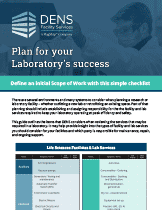Just in time for 2023, the commercial real estate market is bouncing back – especially in Life Sciences hubs such as Boston, where the industry is projected to double in size to encompass 60 million square feet in the next decade.
The Life Sciences sector has grown tremendously over the past several years, thanks to the introduction of new technologies and an increase in both public and private funding.
If you’re in the process of developing a new laboratory space (or retrofitting an existing space), then you understand just how painstaking facilities planning can be, especially Life Sciences facilities. There are hundreds of critical systems and service factors to consider, which can vary depending on the nature of your work.
Part of your planning has to include establishing and assigning responsibility for those systems and services required to keep your laboratory operating at peak efficiency and safety.
Here are three steps you can’t afford to skip as you prepare to open your laboratory doors:
Know Your Systems
From plumbing and HVAC to safety and security, every laboratory is made up of countless critical systems, and each system comprises its own unique equipment. It’s crucial that you’re familiar with your laboratory systems and all their complexities, as they often differ from those found in other commercial facilities.
We recommend taking inventory of all the systems and services that will be needed to keep your laboratory up and running. Not only will this help you get better acquainted with your space, but the inventory list will come in handy as you perform facility check-ups throughout the year. Don’t forget to note any exterior requirements!
 Not sure where to start? Download our Lab Start Up Checklist. Not only does it serve as a comprehensive list of laboratory systems and services, but it can be used to define your initial Scope of Work (SOW) for a Request for Information (RFI) or Request for Proposal (RFP).
Not sure where to start? Download our Lab Start Up Checklist. Not only does it serve as a comprehensive list of laboratory systems and services, but it can be used to define your initial Scope of Work (SOW) for a Request for Information (RFI) or Request for Proposal (RFP).
Think Ahead
Although some laboratory systems require only basic set-up and maintenance, you’ll find that others are much more complex. For example, biological safety cabinets, fume hoods, and filters require regular certification and testing.
Beyond maintenance and repair, testing and certification, and other technical jobs, laboratory management encompasses things like procurement, office support, and vendor coordination. Be sure to plan for these ongoing activities, which are vital to your laboratory operations.
Assign Responsibility
As you create your system inventory, it’s important to establish what party is responsible for each item – whether it be a staff member, contractor, or long-term facilities management partner.
For many laboratories, outsourcing maintenance and support is more practical than performing them in-house. Not only do facilities management providers perform a range of services, but they know how to optimize your laboratory systems. The right partner will work with you to achieve greater cost control, visibility, and quality assurance.
Together, Flagship and DENS provide a host of laboratory support services to Life Sciences clients in Boston and beyond. We know what it takes to keep your facilities running safely and smoothly – from the launch of your lab to product commercialization.
Use our FREE Lab Start Up Checklist as a guide to opening and maintaining a safe and efficient Life Sciences facility.

Blog Comments